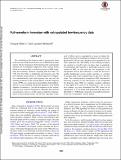| dc.contributor.author | Li, Yunyue | |
| dc.contributor.author | Demanet, Laurent | |
| dc.date.accessioned | 2017-05-03T15:44:05Z | |
| dc.date.available | 2017-05-03T15:44:05Z | |
| dc.date.issued | 2016-05 | |
| dc.date.submitted | 2016-09 | |
| dc.identifier.issn | 0016-8033 | |
| dc.identifier.issn | 1942-2156 | |
| dc.identifier.uri | http://hdl.handle.net/1721.1/108636 | |
| dc.description.abstract | The availability of low-frequency data is an important factor in the success of full-waveform inversion (FWI) in the acoustic regime. The low frequencies help determine the kinematically relevant, low-wavenumber components of the velocity model, which are in turn needed to avoid convergence of FWI to spurious local minima. However, acquiring data less than 2 or 3 Hz from the field is a challenging and expensive task. We have explored the possibility of synthesizing the low frequencies computationally from high-frequency data and used the resulting prediction of the missing data to seed the frequency sweep of FWI. As a signal-processing problem, bandwidth extension is a very nonlinear and delicate operation. In all but the simplest of scenarios, it can only be expected to lead to plausible recovery of the low frequencies, rather than their accurate reconstruction. Even so, it still requires a high-level interpretation of band-limited seismic records into individual events, each of which can be extrapolated to a lower (or higher) frequency band from the nondispersive nature of the wave-propagation model. We have used the phase-tracking method for the event separation task. The fidelity of the resulting extrapolation method is typically higher in phase than in amplitude. To demonstrate the reliability of bandwidth extension in the context of FWI, we first used the low frequencies in the extrapolated band as data substitute, to create the low-wavenumber background velocity model, and then we switched to recorded data in the available band for the rest of the iterations. The resulting method, extrapolated FWI, demonstrated surprising robustness to the inaccuracies in the extrapolated low-frequency data. With two synthetic examples calibrated so that regular FWI needs to be initialized at 1 Hz to avoid local minima, we have determined that FWI based on an extrapolated [1, 5] Hz band, itself generated from data available in the [5, 15] Hz band, can produce reasonable estimations of the low-wavenumber velocity models. | en_US |
| dc.description.sponsorship | TOTAL (Firm) | en_US |
| dc.description.sponsorship | United States. Air Force Office of Scientific Research | en_US |
| dc.description.sponsorship | United States. Office of Naval Research | en_US |
| dc.description.sponsorship | National Science Foundation (U.S.) | en_US |
| dc.description.sponsorship | Massachusetts Institute of Technology. Earth Resources Laboratory | en_US |
| dc.language.iso | en_US | |
| dc.publisher | Society of Exploration Geophysicists | en_US |
| dc.relation.isversionof | http://dx.doi.org/10.1190/GEO2016-0038.1 | en_US |
| dc.rights | Article is made available in accordance with the publisher's policy and may be subject to US copyright law. Please refer to the publisher's site for terms of use. | en_US |
| dc.source | Society of Exploration Geophysicists | en_US |
| dc.title | Full-waveform inversion with extrapolated low-frequency data | en_US |
| dc.type | Article | en_US |
| dc.identifier.citation | Li, Yunyue Elita, and Laurent Demanet. “Full-Waveform Inversion with Extrapolated Low-Frequency Data.” GEOPHYSICS 81.6 (2016): R339–R348. © 2016 Society of Exploration | en_US |
| dc.contributor.department | Massachusetts Institute of Technology. Department of Mathematics | en_US |
| dc.contributor.mitauthor | Li, Yunyue | |
| dc.contributor.mitauthor | Demanet, Laurent | |
| dc.relation.journal | GEOPHYSICS | en_US |
| dc.eprint.version | Final published version | en_US |
| dc.type.uri | http://purl.org/eprint/type/JournalArticle | en_US |
| eprint.status | http://purl.org/eprint/status/PeerReviewed | en_US |
| dspace.orderedauthors | Li, Yunyue Elita; Demanet, Laurent | en_US |
| dspace.embargo.terms | N | en_US |
| dc.identifier.orcid | https://orcid.org/0000-0003-4225-2735 | |
| dc.identifier.orcid | https://orcid.org/0000-0001-7052-5097 | |
| mit.license | PUBLISHER_POLICY | en_US |
